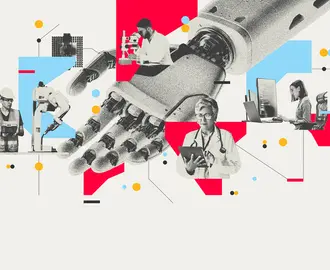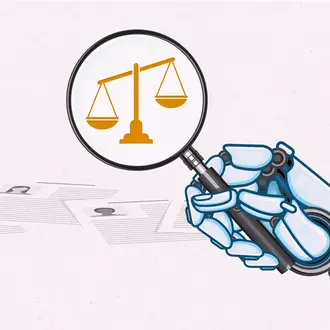Podcast explores how companies use AI to reach customers, innovate
In its 102 years in the dairy business, Land O’Lakes has seen machines, automation, and biotechnology change agriculture.
Now the food company is experiencing another revolution as analytics and artificial intelligence remake agriculture, according to Teddy Bekele, chief technology officer at Land O’Lakes.
“It’s put agriculture in hyperdrive,” Bekele said on “Me, Myself, and AI,” a podcast from MIT Sloan Management Review. Thanks to data about climate, soil composition, and topography, “things that were previously managed with intuition have been improved. You’re more and more reliant on data coming off the field and then making decisions. That really is the change in what’s happening in agriculture today.”
From long-established industries like agriculture, high-stakes fields like air travel and medicine, and wellness innovations such as personalized workouts and fragrances, “Me, Myself, and AI” looks at how companies explore using AI to innovate, reach customers, and increase efficiency.
The podcast is hosted by Sam Ransbotham, a professor of analytics at Boston College, and Shervin Khodabandeh, a senior partner with Boston Consulting Group and a leader of its AI business. The podcast recently launched its sixth season.
Here are some takeaways from the series that businesses can use.
Starting with smart hires at Novo Nordisk
Multinational pharmaceutical company Novo Nordisk is using AI to develop and deliver medicines to treat chronic diseases like diabetes.
When staffing for its data and AI initiatives, people with technical skills are essential and becoming easier to find, said Tonia Sideri, head of Novo Nordisk’s AI center of excellence. Softer skills, however, are more elusive.
“For me, the most important skill of a data scientist is actually empathy — something we don’t expect from people from a technical field usually,” she said. “It’s the ability to go into the businessperson’s mind and ask themselves, ‘If I were a marketer, if I were a production operator, and I had to do the job every day, and I had the problems that I have, how would I use the data for something that would be useful for me?’”
Making these leaps requires empathy and curiosity. “And [those are] very difficult skills to quantify or interview for. It’s more of a cultural or a character trait,” Sideri said.
Keeping humans in the loop at Orangetheory
Data and AI are key tools at Orangetheory Fitness, where people participating in its group workouts wear fitness trackers to monitor their heart rates and whether they are reaching their fitness goals.
Related Articles
But humans have to buy into the strategy, said Ameen Kazerouni, the company’s chief data and analytics officer. “You’re convincing domain experts — in our case, fitness experts — that have been doing this for a long time, that are formally educated in these fields of study, that are always going to know more about the product than you do, that an algorithm is going to help them and make their job easier,” he said. “The AI, the data team, and the fitness team need to be in lockstep; otherwise, it’s destined to fail.”
And while it is essential to gather data and invest in data engineers, humans and strong partnerships between different business units are also needed to provide solutions.
“One thing that I’ve learned about data over the course of my career is that data is valuable, and it’s really good to make decisions with, but if there’s a human in the loop that can scalably provide the answer instead, it’s likely going to be hard to beat that expert with an algorithm,” Kazerouni said. “So don’t get in the way of the expert.”
If someone injured their foot or ran a marathon the previous day, they might need to modify their workout, he said. The real-time feedback loop “allows you and the coach to modulate yourself.”
Balancing safety and innovation at Boeing
AI could be used to improve airport and air space efficiency and enhance flight safety, said Helen Lee, regional director of air traffic management and airport programs in China for Boeing.
But it is still not widely used for those purposes, Lee said. Security is one hurdle — systems must be immune from hacking, for example — and so is reliability. And voice recognition systems must be 100% accurate. “In the air traffic management world, there’s zero tolerance for mistakes,” she said. “So it’s not like your Siri, where if you make a mistake, that’s fine; you just say it again. But not here; you cannot do it.”
But a few applications are coming close to fruition, Lee said. One is image recognition — using a robotic camera to take pictures of an aircraft as it lands to see whether there’s any damage, and using AI to determine whether anything needs to be fixed immediately.
Speech recognition could also be used to recognize cockpit conversations with air traffic controllers. Sometimes instructions from controllers are the same for different aircraft, and that could be digitized. “If an aircraft has to be rerouted to another path, that would be another thing that can be digitized using speech recognition,” Lee said, adding that digitization could help reduce pilot errors.
Using AI to personalize products at Estée Lauder
Cosmetics company Estée Lauder uses data and artificial intelligence to learn more about customers’ preferences, create products, and improve supply planning, said Sowmya Gottipati, head of global supply chain technology for Estée Lauder.
“We can use data to inform ourselves [about] what kind of ingredients and what type of products that people like, and so we can inform our product planning using AI,” she said. For example, the company rolled out an AI application for supply and demand planning. “Before, it was spreadsheets and those kinds of things. The moment we started using [an] AI application, we saw … 30% increases in our forecasting accuracy.”
Estée Lauder also uses AI to create programs for people to “try on” products digitally — 30 shades of lipstick in 30 seconds, or 56 shades of foundation that are all slightly different, Gottipati said.
“How do you try so many different foundations? You can’t, whereas AI can narrow it down for you,” she said. “These virtual try-on applications can narrow it down to two or three, and from there, a beauty adviser can actually work with the customer.”



